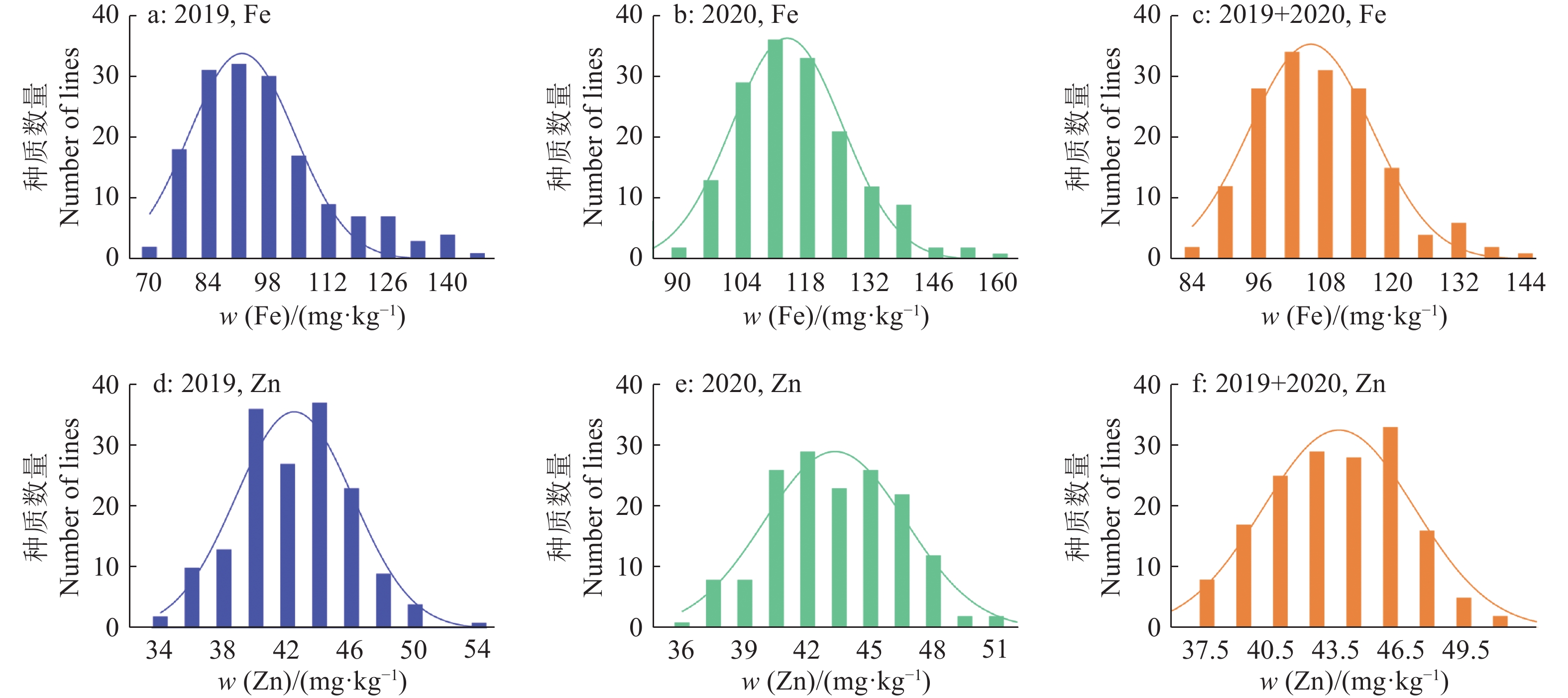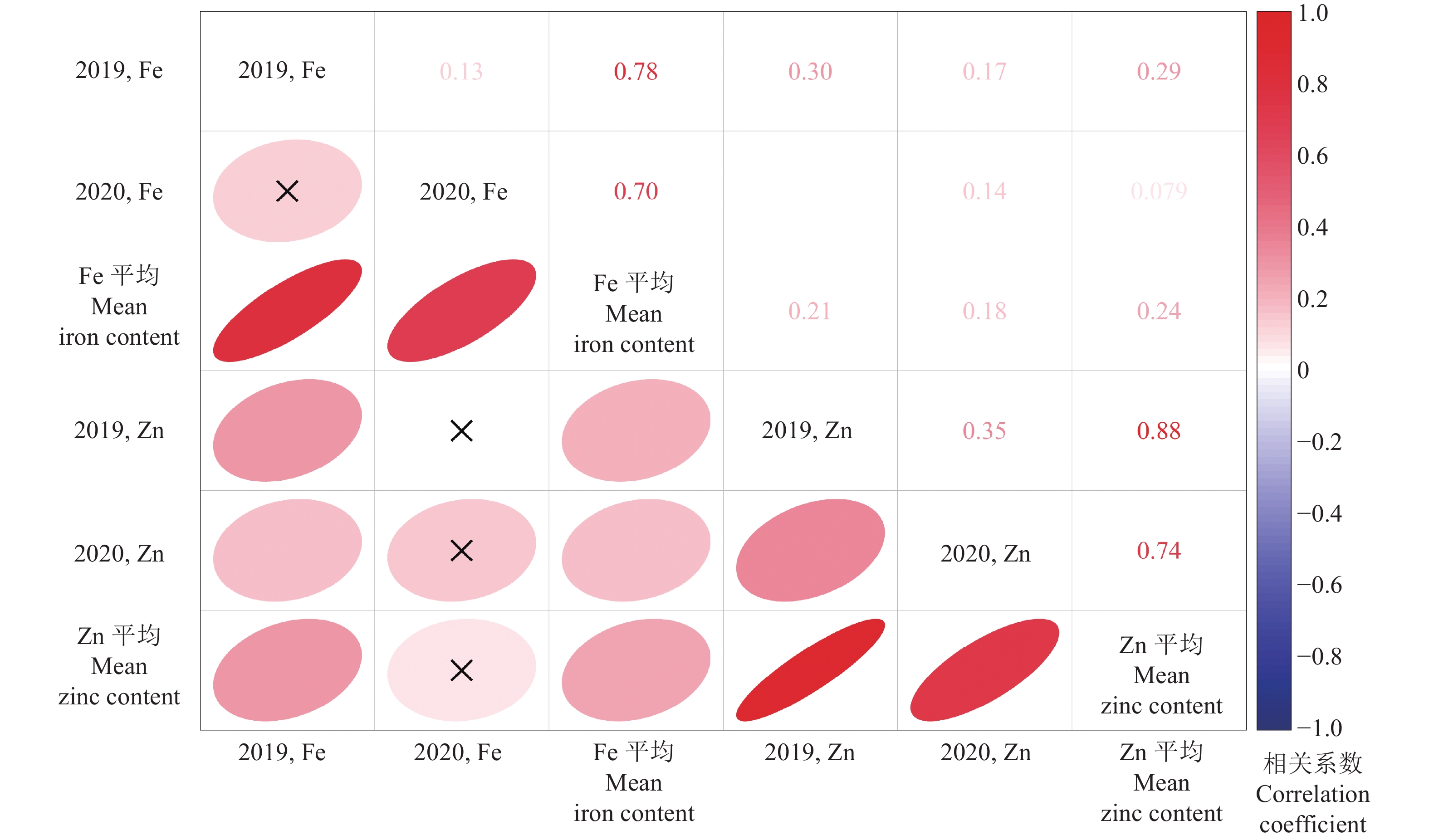Accurate identification and correlation analysis of iron and zinc contents in soybean core accessions
-
摘要:目的
针对中国居民因铁、锌等微量元素摄取不足引发的营养不良问题,开展大豆核心种质籽粒铁、锌含量的精准鉴定。
方法以国内外来源不同的163份大豆核心种质为材料,2019—2020年种植于华南农业大学试验教学基地,采用火焰原子吸收光谱仪测定籽粒铁和锌的含量,并进行相关性分析。
结果大豆种质籽粒铁、锌含量在年份间存在显著差异(P<0.05);籽粒铁质量分数为71.02~159.92 mg·kg−1,平均为107.09 mg·kg−1;籽粒锌质量分数为36.32~53.11 mg·kg−1,平均为42.80 mg·kg−1。相关性分析发现,不同年份间籽粒铁与锌含量存在正相关关系,说明这2个元素在大豆籽粒吸收中存在较强的相互促进关系。利用概率分级法将163份大豆种质籽粒铁、锌元素含量分为5级(即极低、低、中、高和极高),综合分析筛选出4份高铁含量、4份高锌含量、5份低铁含量、6份低锌含量和2份铁锌含量双高的大豆种质。
结论鉴定出多份不同来源的高/低铁、锌含量的大豆种质,可用于富铁、锌大豆新品种的选育和种质创新,同时也为营养功能型新品种遗传基础解析提供基础材料,加快推动大豆核心种质在华南地区的开发与利用。
Abstract:ObjectiveAiming at the malnutrition problem caused by iron (Fe) and zinc (Zn) minerals deficiency for Chinese people, it is significant to conduct the accurate identification of Fe and Zn contents in soybean core accessions.
MethodThe 163 domestic and foreign soybean core accessions were planted in teaching base of South China Agricultural University consecutively in the early season from 2019 to 2020. The contents of two trace elements of Fe and Zn in the sample grains, were measured by flame atomic absorption spectrometer method, and the correlation analysis was carried out.
ResultThere were significant differences in the contents of two trace elements between the test years (P<0.05). The variation range of grain Fe content of soybean germplasm resources in two years was 71.02−147.91 mg·kg−1, the average Fe content was 107.09 mg·kg−1, and the variation range of grain Zn content was 36.32−53.11 mg·kg−1, the average content of Zn was 42.80 mg·kg−1. There was a positive correlation between Fe and Zn contents in grains of 163 soybean lines from different sources in different years, indicating that there was a strong mutual promotion between two elements. The mineral contents of 163 soybean accessions were divided into five grades by probability grading method, namely extremely low, low, medium, high and very high. And four soybean accessions with high Fe content, four with high Zn content, five with low Fe content, six with low Zn content and two with high Fe and Zn contents were screened out.
ConclusionThe soybean core accessions screened with high/low Fe and Zn content in this study can not only be used for breeding new accessions rich in Fe and Zn content, but also provide the valuable materials for elucidating the genetic basis of functional and new nutrition accessions, and accelerate the use of soybean core accessions and promote the development of soybean production in the South China area.
-
Keywords:
- Soybean /
- Core accession /
- Identification /
- Iron content /
- Zinc content /
- Correlation analysis
-
-
表 1 163份大豆种质的编号与名称
Table 1 Number and name of 163 soybean accessions
编号
No.名称
Name编号
No.名称
Name编号
No.名称
Name编号
No.名称
Name编号
No.名称
Name1 BX1 34 泉豆27 67 HX13 100 华春2号 133 耐荫黑豆 2 BX2 35 泉豆5号 68 HX14 101 HX3 134 新晃黑豆 3 BX3 36 圣豆40 69 HX16 102 2015-XT-23 135 永顺黑豆 4 BX4 37 M6-497 70 HX17 103 2015XT-35 136 徐豆20 5 BX5 38 M桂2-599 71 HX18 104 瓦窑黄豆 137 南农99-6 6 BX6 39 Y15 72 HX20 105 桂早1号 138 赣2016-7 7 BX7 40 Y16 73 HX21 106 桂0112-3 139 赣豆10 8 BX8 41 Y1697 74 HX22 107 桂0114-4 140 赣豆5 9 BX9 42 Y1800 75 HX23 108 桂0513-3 141 赣豆7 10 BX10 43 Y19 76 HX24 109 桂1605 142 S2 11 BX11 44 Y3 77 HX25 110 桂1701 143 S20 12 BX12 45 Y4 78 粤春2013-1 111 桂1702 144 Young 13 BX14 46 Y5 79 粤春2014-2 112 桂1703 145 S427/5/7 14 BX15 47 Y6 80 粤春2015-2 113 桂春16号 146 S519/6/14 15 BX16 48 本地2号 81 粤春2017-1 114 桂春1805 147 SOMA 16 BX17 49 华春1号 82 粤夏05-3 115 桂春1号 148 TGX1803-20E 17 BX18 50 华春3号 83 粤夏05-5 116 桂春5 149 TGX1903-3F 18 ICA-6-2 51 华春5 84 粤夏2012-1 117 桂春豆1号 150 TGX1908-89 19 BX13 52 华春6号 85 粤夏2013-1 118 桂夏1801 151 OPE-Para4 20 中黄24 53 华春7号 86 粤夏2013-2 119 桂夏1802 152 TGX48-30-20F 21 福豆12 54 华春8号 87 粤夏2013-4 120 桂夏7号 153 简阳五月黄 22 福豆15 55 华春10号 88 粤夏2014-3 121 桂夏豆109 154 贡秋豆5号 23 福豆234 56 华春11号 89 粤夏2014-6 122 桂夏豆116 155 贡夏6973 24 福豆310 57 华春12号 90 粤夏2016-1 123 桂夏豆117 156 贡夏7103 25 莆豆019 58 粤春2016-1 91 粤夏2016-2 124 桂夏豆118 157 贡夏8173 26 莆豆014 59 粤春2016-2 92 粤夏2016-4 125 桂夏豆119 158 贡选1号 27 莆豆041 60 HX1 93 粤夏2017-1 126 桂夏豆2号 159 滇86-5 28 莆豆5号 61 HX2 94 粤夏2017-2 127 黔豆6号 160 滇豆4号 29 莆豆611 62 HX4 95 粤夏2017-3 128 冀豆12 161 滇豆7号 30 莆豆704 63 HX5 96 粤夏2018-1 129 冀豆17 162 浙春3号 31 莆豆8008 64 HX6 97 粤夏2018-2 130 天隆1号 163 浙春4号 32 泉豆24 65 HX9 98 粤小黄粒1 131 中豆32 33 泉豆26 66 HX10 99 粤小黄粒3 132 中豆41 表 2 仪器工作条件
Table 2 Working conditions of instrument
元素
Elementλ/nm
Wave lengthI灯/mA
Lamp current狭缝宽度/nm
Slit width燃头高度/mm
Burner height点灯方式
Lighting method燃气流量/(L·min−1)
Gas flow助燃气
Supporting gasFe 248.3 12 0.2 9.0 BGC-D2 2.2 空气 Zn 213.9 8 0.7 7.0 BGC-D2 2.0 空气 表 3 不同年份163份大豆种质籽粒铁、锌含量的描述性统计
Table 3 Descriptive statistical of grain Fe and Zn content in 163 soybean accessions in two years
元素
Element年份
Yearw/(mg·kg−1) 变异系数/%
Coefficient
of variationK-S检验 K-S test F1) 最小值
Minimum最大值
Maximum平均值
Mean标准差
Standard
deviation偏度
Skewness峰度
KurtosisSig.值
Sig. valueFe 2019 71.02 147.91 97.17 16.02 16.49 1.01 0.63 0.00 12.09** 2020 90.19 159.92 117.02 13.00 11.11 0.58 0.44 0.20 7.58** 平均 Mean 84.14 144.86 107.09 11.22 10.48 0.65 0.51 0.20 2.02** Zn 2019 34.62 53.11 42.41 3.48 8.21 0.11 −0.10 0.20 30.62** 2020 36.32 51.47 43.41 3.06 7.05 0.03 −0.42 0.20 1.31* 平均 Mean 37.03 49.51 42.80 2.45 6.43 0.00 −0.66 0.20 3.71** 1) “*”和“**”分别表示数据在0.05和0.01水平上差异显著
1) “*” and “**” indicate there were significant difference at 0.05 and 0.01 levels, respectively表 4 163份大豆种质籽粒铁、锌含量概率分级1)
Table 4 Probability classification of grain Fe and Zn contents of 163 soybean accessions
w/(mg·kg−1) 元素
Element年份
Year1/极低
1/Very low2/低
2/Low3/中级
3/Middle4/高
4/High5/极高
5/Very highFe 2019 < 76.64(7) 76.64 ~ 88.77(50) 88.77 ~ 105.57(66) 105.57 ~ 117.70(16) > 117.70(22) 2020 < 100.36(15) 100.36 ~ 110.20(31) 110.2 ~ 123.84(19) 123.84 ~ 133.68(25) > 133.68(16) 平均 Mean < 92.71(14) 92.71 ~ 101.20(40) 101.2 ~ 112.98(64) 112.98 ~ 121.47(32) > 121.47(13) Zn 2019 < 37.95(17) 37.95 ~ 40.58(31) 40.58 ~ 44.24(60) 44.24 ~ 46.87(40) > 46.87(14) 2020 < 39.49(16) 39.49 ~ 41.8(29) 41.8 ~ 45.02(58) 45.02 ~ 47.33(36) > 47.33(16) 平均 Mean < 39.28(21) 39.28 ~ 41.36(29) 41.36 ~ 44.24(57) 44.24 ~ 46.32(38) > 46.32(18) 1) 括号中数据为相应概率等级的种质数量
1) Data in brackets represent the number of the soybean accessions in the corresponding probability classification表 5 大豆种质籽粒铁、锌含量突出表现材料概要1)
Table 5 Summary of soybean accessions with prominent grain Fe and Zn contents
类型
TypeFe含量突出 Outstanding Fe content Zn含量突出 Outstanding Zn content 名称 Name w(Fe)/(mg·kg−1) 名称 Name w(Zn)/(mg·kg−1) 高含量
High content粤夏2018-2 144.86±23.10 桂夏豆116 49.51±1.64 BX17 140.13±8.35 桂夏豆109 48.92±2.43 TGX1803-20E 131.44±7.05 贡夏6973 47.85±4.40 华夏24 130.76±9.50 赣豆7 47.74±2.19 圣豆40 130.08±4.14 粤春2017-1 47.56±2.00 桂夏豆117 47.11±1.62 桂夏7号 47.10±0.70 OPE-Para4 46.96±1.65 双高含量
Double high content桂1701 136.30±13.67 桂1701 47.58±3.16 桂夏豆109 127.33±6.02 桂夏豆109 48.92±2.43 低含量
Low content粤春2015-2 84.14±12.12 S519/6/14 37.03±1.94 TGX1908-89 84.38±6.96 中豆41 37.28±2.11 S20 87.12±12.10 桂春5 37.47±2.55 莆豆5号 88.77±10.81 Y4 37.62±2.43 粤夏2017-2 90.63±5.63 Y6 37.83±2.89 桂春1号 37.89±2.11 双低含量
Double low contentS20 87.12±12.10 S20 39.12±2.20 瓦窑黄豆 90.91±14.39 瓦窑黄豆 38.44±5.49 Y6 91.40±10.44 Y6 37.83±2.89 BX5 91.62±15.66 BX5 38.97±0.96 1) 表中数据为3次重复的平均值±标准差
1) The data in the table show the mean ± standard deviation of three replicates -
[1] 梁勇. 2022年7月世界农产品供需形势预测简报[J]. 世界农业, 2022(8): 127-132. doi: 10.3969/j.issn.1002-4433.2022.8.shijny202208013 [2] 寇坤. 大豆SOC1a和SOC1b基因调控开花的功能研究[D]. 哈尔滨: 中国科学院东北地理与农业生态研究所, 2021. [3] SEDIVY E J, WU F Q, HANZAWA Y. Soybean domestication: The origin, genetic architecture and molecular bases[J]. The New Phytologist, 2017, 214(2): 539-553. doi: 10.1111/nph.14418
[4] 张东辉, 杨青春, 耿臻, 等. 有机大豆营养功效及栽培技术[J]. 农业工程, 2017, 7(2): 136-137. [5] DONG Y, YANG X, LIU J, et al. Pod shattering resistance associated with domestication is mediated by a NAC gene in soybean[J]. Nature Communication, 2014, 5: 3352. doi: 10.1038/necmms4352.
[6] MESSINA M, ROGERO M M, FISBERG M, et al. Health impact of childhood and adolescent soy consumption[J]. Nutrition Reviews, 2017, 75(7): 500-515. doi: 10.1093/nutrit/nux016
[7] HUANG J H, MA Q B, CAI Z D, et al. Identification and mapping of stable QTLs for seed oil and protein content in soybean [Glycine max (L.) Merr.][J]. Journal of Agricultural and Food Chemistry, 2020, 68(23): 6448-6460. doi: 10.1021/acs.jafc.0c01271
[8] RIZZO G, BARONI L. Soy, soy foods and their role in vegetarian diets[J]. Nutrients, 2018, 10(1): 43. doi: 10.3390/nu10010043.
[9] ZHANG Y, GLADYSHEV V N. Comparative genomics of trace element dependence in biology[J]. Journal of Biological Chemistry, 2011, 286(27): 23623-23629. doi: 10.1074/jbc.R110.172833
[10] LIM K H, RIDDELL L J, NOWSON C A, et al. Iron and zinc nutrition in the economically-developed world: A review[J]. Nutrients, 2013, 5(8): 3184-3211. doi: 10.3390/nu5083184
[11] 孙汉青, 刘力宽, 刘韬, 等. 青海23份春小麦铁、锌含量分析[J]. 分子植物育种, 2019, 17(19): 6563-6569. [12] ROY C, KUMAR S, RANJAN R D, et al. Genomic approaches for improving grain zinc and iron content in wheat[J]. Frontiers in Genetics, 2022, 13: 1045955. doi: 10.3389/fgene.2022.1045955.
[13] KRISHNA T P A, MAHARAJAN T, CEASAR S A. The role of membrane transporters in the biofortification of zinc and iron in plants[J]. Biological Trace Element Research, 2022, 201: 464-478.
[14] MARRIOTT B P, BIRT D F, STALLINGS V A, et al. Present Knowledge in Nutrition [M]. 11th Edition. London: Academic Press, 2020.
[15] WELCH R M, GRAHAM R D. Breeding crops for enhanced micronutrient content[J]. Plant and Soil, 2002, 245(1): 267-276.
[16] 朱行. 富含铁元素水稻新品种[J]. 粮食与油脂, 2006, 19(4): 31. [17] GARG M, SHARMA N, SHARMA S, et al. Biofortified crops generated by breeding, agronomy, and transgenic approaches are improving lives of millions of people around the world[J]. Frontiers in Nutrition, 2018, 5: 12. doi: 10.3389/fnut.2018.00012.
[18] 青平, 曾晶, 李剑, 等. 中国作物营养强化的现状与展望[J]. 农业经济问题, 2019, 40(8): 83-93. [19] 刘慧. 我国主要麦区小麦籽粒产量和关键营养元素含量评价及调控[D]. 杨凌: 西北农林科技大学, 2016. [20] 张勇, 王德森, 张艳, 等. 北方冬麦区小麦品种籽粒主要矿物质元素含量分布及其相关性分析[J]. 中国农业科学, 2007, 40(9): 1871-1876. [21] 杨治伟. 宁夏粳稻种质资源锌、铁含量的关联分析及地方品种籽粒锌含量的QTL定位[D]. 银川: 宁夏大学, 2019. [22] 张标金, 聂根新, 魏益华, 等. 水稻子粒铁、锌和铜含量的基因型差异分析[J]. 作物杂志, 2014(5): 48-51. [23] 董慕新, 张辉. 我国八省大豆主要矿质元素含量分布及相关性研究[J]. 作物学报, 1997, 23(5): 550-554. [24] BOUIS H E, HOTZ C, MCCLAFFERTY B, et al. Biofortification: A new tool to reduce micronutrient malnutrition[J]. Annals of Nutrition and Metabolism, 2009(55): 57-58.
[25] 黄欢明. 国家热带亚热带地区夏大豆品种区域试验[J]. 福建农业科技, 2018(9): 37-41. [26] 邓佑林, 陆婷婷, 黄秀香, 等. 原子吸收分光光度法测定柚子皮中的铜和钾[J]. 化工技术与开发, 2019, 48(9): 39-42. [27] 叶发兵, 袁娇, 何彦斌, 等. 鄂东茯苓中重金属离子铜、镉含量的测定[J]. 湖北农业科学, 2016, 55(16): 4269-4271. [28] 王思琦, 宋记明, 曹敏, 等. 不同木薯种质资源主要矿物质元素差异性分析[J]. 热带作物学报, 2022, 43(8): 1577-1586. [29] 聂继云, 李志霞, 李海飞, 等. 苹果理化品质评价指标研究[J]. 中国农业科学, 2012, 45(14): 2895-2903. [30] WANG H, JIA J, CAI Z D, et al. Identification of quantitative trait loci (QTLs) and candidate genes of seed iron and zinc content in soybean [Glycine max (L.) Merr.][J]. BMC Genomics, 2022, 23(1): 1-14. doi: 10.1186/s12864-021-08243-4
[31] GARCIA-OLIVEIRA A L, CHANDER S, ORTIZ R, et al. Genetic basis and breeding perspectives of grain iron and zinc enrichment in cereals[J]. Frontiers in Plant Science, 2018, 9: 937. doi: 10.3389/fpls.2018.00937.
[32] 何一哲. 高铁锌食药兼用小麦: 秦黑1号[J]. 农家科技, 2007(10): 7. [33] 余赛西. 大豆在萌发过程中的铁锌营养强化[D]. 海口: 海南大学, 2018. -
期刊类型引用(1)
1. 孙浩月,韩冬伟,张笛,王振,朱治佳,王连霞,张金东,李明,袁明. 160份大豆种质资源鉴定评价及表型多样性分析. 种子. 2025(02): 124-132 .  百度学术
百度学术
其他类型引用(1)




 下载:
下载:


